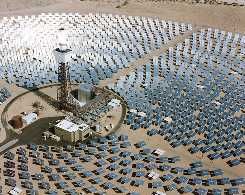Concentrated Solar Power — Opportunities Flourishing?

Whilst Spain has been a strong driving force for the CSP industry worldwide with more than 20 years’ experience in research and technology developments, the government support is what have made the development of this technology extremely lucrative in the country. But the approval in 2011 of a royal decree temporarily suspending all economic incentives for renewable sources, has shaken the CSP industry to the core.
Furthermore, the global economic downturn and the lower prices of PV and natural gas have not made 2012 an easy year for the Concentrated Solar Thermal industry worldwide. But despite the challenging times and the need for the sector to re-define its strategy to become a true contender in the global energy generation mix, the opportunities continue to flourish around the globe.
I’d like to think that last sentence is true, i.e., that CSP opportunities are, in fact, flourishing around the globe. The first part of the blurb is most certainly true: these last years have been tough for the industry. Unfortunately, the unchallenged leader in CSP development is Spain, and the European financial mess has hit them hard.
In my estimation, it will be a terrific tragedy for our civilization if CSP does not receive the opportunity that solar PV and wind did: several decades of R&D that resulted in terrific breakthroughs – particularly in cost.

CSP has both advantages and disadvantages over PV.
With CSP systems that generate a high enough temperature, energy can be stored as heat in molten salt tanks thereby permitting the system to generate electricity after sunset. It can also be more efficient than PV. On the other hand, CSP will not work except in direct sunlight whereas PV will work, although with considerably reduced output, on cloudy days.
For maximum efficiency and minimum capital costs, CSP requires water cooling of the condensers which is a problem in areas where water is scarce. That is especially true with trough systems since they cannot generate at as high a temperature as the power tower system. Therefore, the practicality is lower in some desert areas where sunlight tends to be most reliable. PV requires no cooling.
Of course, both require sunlight to produce power and therefore neither can substitute for systems which will provide power 24 hours per day 365 days per year. Thus, even if the total capacity of all solar systems were 10 times what a country required, they could not provide reliable power. With currently available technology, solar and wind systems are dependent on either nuclear or fossil fueled systems for backup. Thus, the cost of solar and wind systems is IN ADDITION TO the cost of nuclear and fossil fueled systems, a fact which must be considered when computing the actual cost of electricity generated by renewable systems, a fact which is often overlooked.